Automation vs AI Agent: What’s the Difference?
Learn the key differences between automation vs AI agent. Discover practical insights to choose the best tool for your business needs.
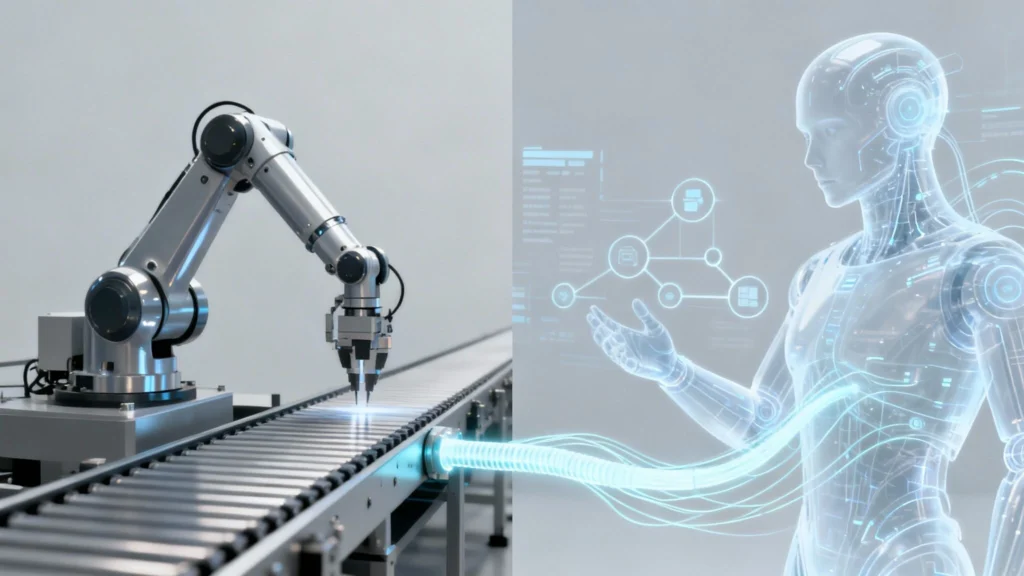
Llet’s talk about the difference between automation and an AI agent. Honestly, when you get right down to it, it’s pretty simple. Automation is like following a strict recipe—it does the exact same predefined tasks, perfectly, every single time. An AI agent, though… that’s different. You give it a goal, and it has the smarts to think, learn, and figure out how to get there, even when things get a bit messy.
Defining the Core Difference Between Automation and AI
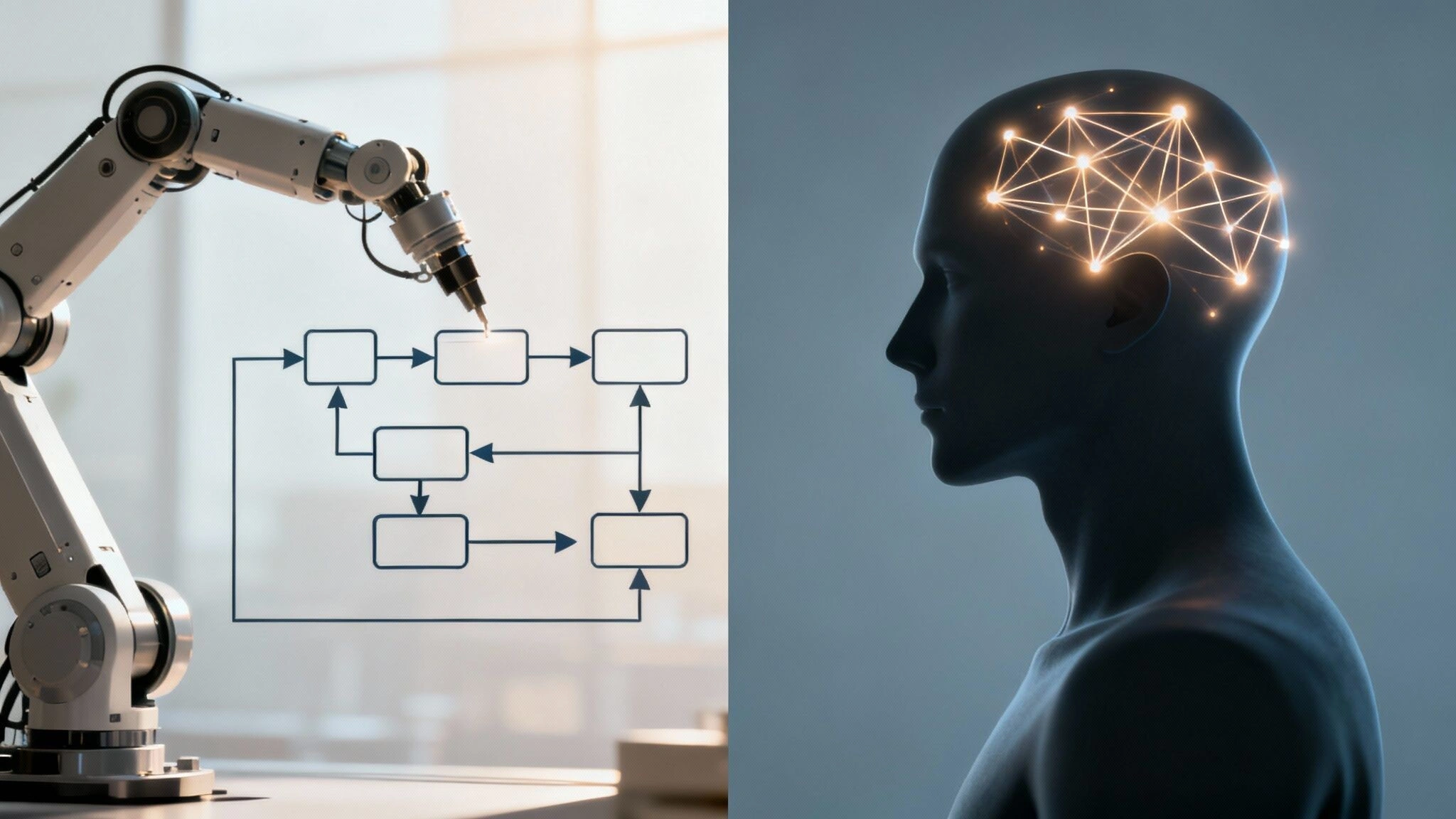
You’re hearing these words everywhere, right? It feels like every second chat is about ‘automating this’ or ‘deploying an AI for that’. And you know what? It’s so easy to get them tangled up. They both promise to make our work lives a bit easier, but they’re completely different tools for entirely different jobs.
Let’s just clear this up, you and me.
Think of standard automation as the most reliable, almost obsessive, recipe follower you’ve ever met. It’s a master of anything predictable. You give it a clear set of ‘if this happens, then do that’ instructions, and it’ll follow them flawlessly, thousands of times over, without ever getting tired or slipping up. It’s brilliant for those tasks that are super important but… well, they’re soul-crushingly boring.
An AI agent is another kettle of fish. It’s less of a recipe follower and more like a clever apprentice you’ve just brought on board. You don’t hand it a step-by-step to-do list… you give it a goal. An outcome you want. It can learn from new info, adapt to stuff you didn’t see coming, and make its own calls to get the job done.
The Key Distinctions
This is a hot topic for a good reason. Businesses all over the country are trying to figure out where these tools fit. And the whole thing is moving fast. Here in Australia, over 35% of businesses are already using this stuff as of 2024 to get more efficient and just keep up. You can read more about Australian AI adoption trends if you’re curious.
This big shift makes getting the difference right even more crucial. Because getting it wrong means wasted time and money. I’ve seen it happen.
The real split is in the thinking. Automation does a process you’ve already figured out. An AI agent understands a goal and figures out the process for itself.
To make this even clearer, let’s just look at a quick side-by-side.
At a Glance: Automation vs. AI Agent
This simple table breaks it all down, giving you a quick reference for what they’re each good for.
| Core Function | Standard Automation | AI Agent |
|---|---|---|
| Primary Role | Follows predefined rules and scripts. | Pursues a goal with autonomy. |
| Decision Making | Based on “if-then” logic. | Learns, reasons, and adapts. |
| Data Handling | Works best with structured, predictable data. | Can process unstructured, messy data. |
| Flexibility | Rigid. Fails if conditions change. | Highly adaptable to new information. |
We’ll dive into the nitty-gritty of where each one really shines in a moment. But for now, just hold onto that idea: automation is your dependable rule-follower, and the AI agent is your adaptive problem-solver.
Exploring Automation: The Dependable Rule-Follower
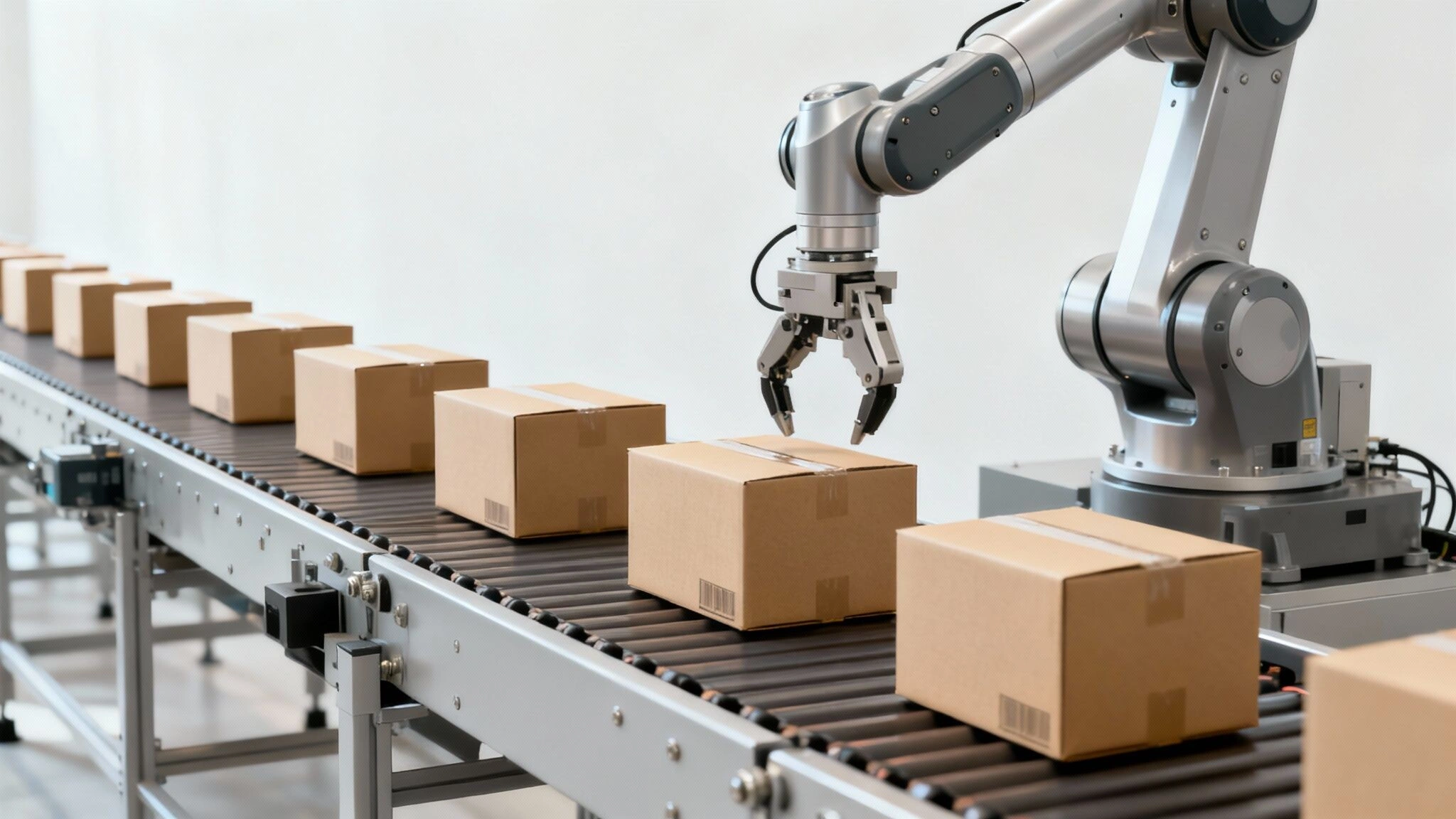
Okay, let’s properly unpack automation, and get past all the marketing fluff to what it actually is.
Imagine your most dependable employee. The one who’s never late, never makes a typo, and follows instructions to the letter, every single time. That’s automation. That’s its soul.
Its true power is in that rock-solid consistency. It’s the engine that just churns through all those high-volume, predictable jobs that are vital for the business but slowly drain the life out of your team. We all know those tasks. The ones that make you question your life choices at 3 PM on a Tuesday.
What Automation Does Best
We’re talking about jobs that follow a clear, unchanging script. A specific trigger happens, and a set sequence of actions follows. No guesswork. None.
Here are a few classic examples:
- Sending a receipt: A customer buys something online. Instantly, an email receipt is made and sent out. The process is identical every single time.
- Generating a weekly report: Every Friday at 5 PM, the system grabs sales figures from specific places, pops them into a template, and emails it to the bosses.
- Onboarding a new employee: An HR manager changes a candidate’s status to ‘hired’. That one click can kick off a whole chain reaction: creating an email account, adding them to payroll, sending out the standard first-day info.
It’s all about taking a manual, repetitive workflow and making it hands-off. And this isn’t just about saving a bit of time. It’s about freeing up your clever people from doing robotic work so they can solve problems that actually need a human brain. If you want to dig deeper, our guide on what is workflow automation is a great place to start.
The value is pretty simple. It delivers speed, accuracy, and scale for any process that’s built on clear rules.
The core idea of automation is this: if you can map out the steps in a flowchart, you can probably automate it. It doesn’t improvise… and that’s its greatest strength.
And this isn’t just for big corporations. Automation is making huge waves in the public sector here in Australia. Take Services Australia. They’ve put automation right at the centre of their strategy. By late 2024, they’d rolled out over 600 automated processes for everything from reading claim documents to routing calls with smart voice systems. You can read more about Services Australia’s strategy on their official site.
The Limits of a Rule-Follower
But here’s the crucial bit of the conversation. The part that people often miss. Understanding what automation can’t do is just as important as knowing what it can.
Because it follows a rigid script, it falls over the second that script changes. If a customer fills out a form wrong or an invoice shows up in a weird format, a standard automation will likely just stop. Dead in its tracks. It’ll flag an error and wait for a person to come and fix the problem.
It has zero ability to understand context or what someone meant to do. It can’t read between the lines of a strange customer question. It just sees data that doesn’t fit the rules it was given.
This rigidity is its big limitation. It’s perfect for stable, predictable environments. But the moment you introduce a bit of ambiguity or the need for judgement… you start to see the cracks. And that’s exactly where the conversation turns to its smarter cousin, the AI agent.
Understanding AI Agents: The Adaptive Problem-Solver
Now we get to the really fun part: AI agents. This is where the game truly changes.
If automation is a train running on a fixed track, an AI agent is more like a delivery driver with a destination and live GPS. The driver knows the goal—get the package there—but can react to a sudden traffic jam, a closed road, or a text from the customer changing the drop-off spot. It reroutes as it goes.
An agent is driven by goals, not just a list of strict instructions.
It’s built to understand its environment, which means it can make sense of messy, unstructured stuff. Think of an angry customer email, a complex support ticket with a long history, or a sudden dip in your sales data. An agent doesn’t just read the words; it gets the feeling and the context behind them. From there, it decides on the best thing to do next.
More Than Just a Task-Doer
An AI agent is designed to handle ambiguity. It’s not just about doing a task; it’s about reasoning through a problem to get the best possible result.
Let’s take a logistics agent for example. It wouldn’t just blindly follow a pre-set delivery run. Instead, it would constantly be looking at a whole bunch of moving parts:
- The weather forecast and how it might cause delays.
- Live traffic data from across the city.
- How urgent each delivery is.
- Which routes are the most fuel-efficient.
Based on all this live info, the agent could dynamically reroute an entire fleet of vans to make sure every package gets where it needs to go as efficiently as possible. This is a level of complex problem-solving that simple automation just can’t handle. To see this in action, looking at top AI content creation tools offers a great window into how agents can generate incredibly varied and complex outputs based on a simple prompt.
An AI agent doesn’t ask, “What are my instructions?” It asks, “What’s the goal, and what’s the smartest way to get there right now, given everything I know?”
This ability to adapt is exactly why AI agents are becoming such a big deal for businesses. This chart here breaks down the fundamental differences in how automation and AI agents look at data and decisions.
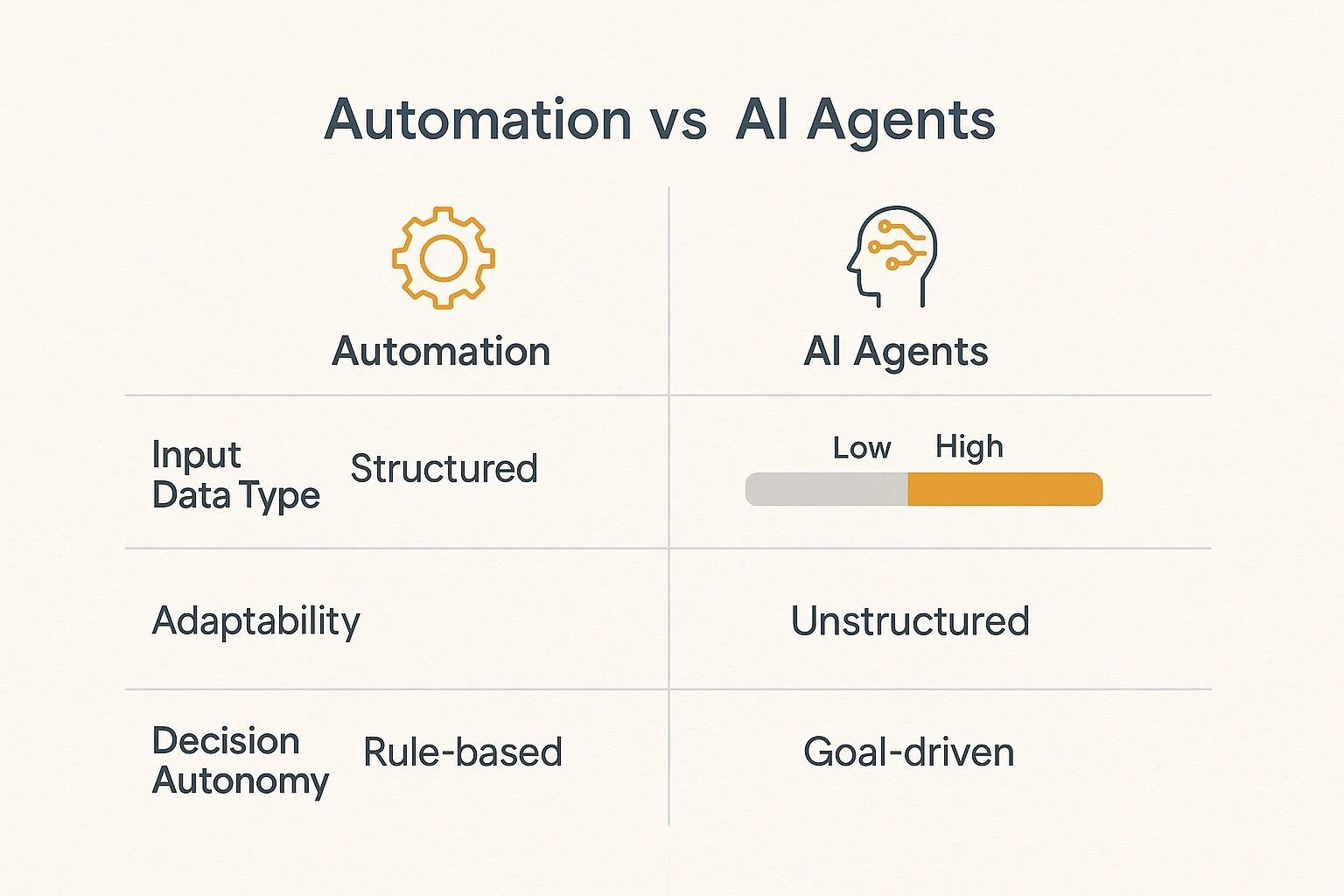
As you can see, the main difference is adaptability and the kind of data each can work with. We’re moving away from systems that need everything to be perfect and structured, towards ones that can handle the dynamic, messy reality of business.
How AI Agents Learn and Decide
So, how do they actually pull this off? Well, an agent isn’t programmed for every single thing it might come across. That would be impossible. Instead, it learns from huge amounts of data, which lets it spot patterns and connections that a person might easily miss. This learning builds a sort of foundational understanding that allows it to make smart predictions and judgements when it sees something completely new.
This is a massive leap from old-school, rule-based systems. It’s what lets an agent, for example, manage a complex customer service issue from start to finish. It can understand the customer’s mood, pull up their whole history with the company, figure out what the root of the problem is, and decide on the best solution—whether that’s giving a refund, sending the ticket to a human expert, or providing clear technical steps. For a deeper look into their mechanics, you might be interested in our guide on what is an AI agent.
Ultimately, their power to handle ambiguity and make their own decisions is what makes them perfect for the complex, always-changing challenges of modern business.
Comparing How They Operate in the Real World
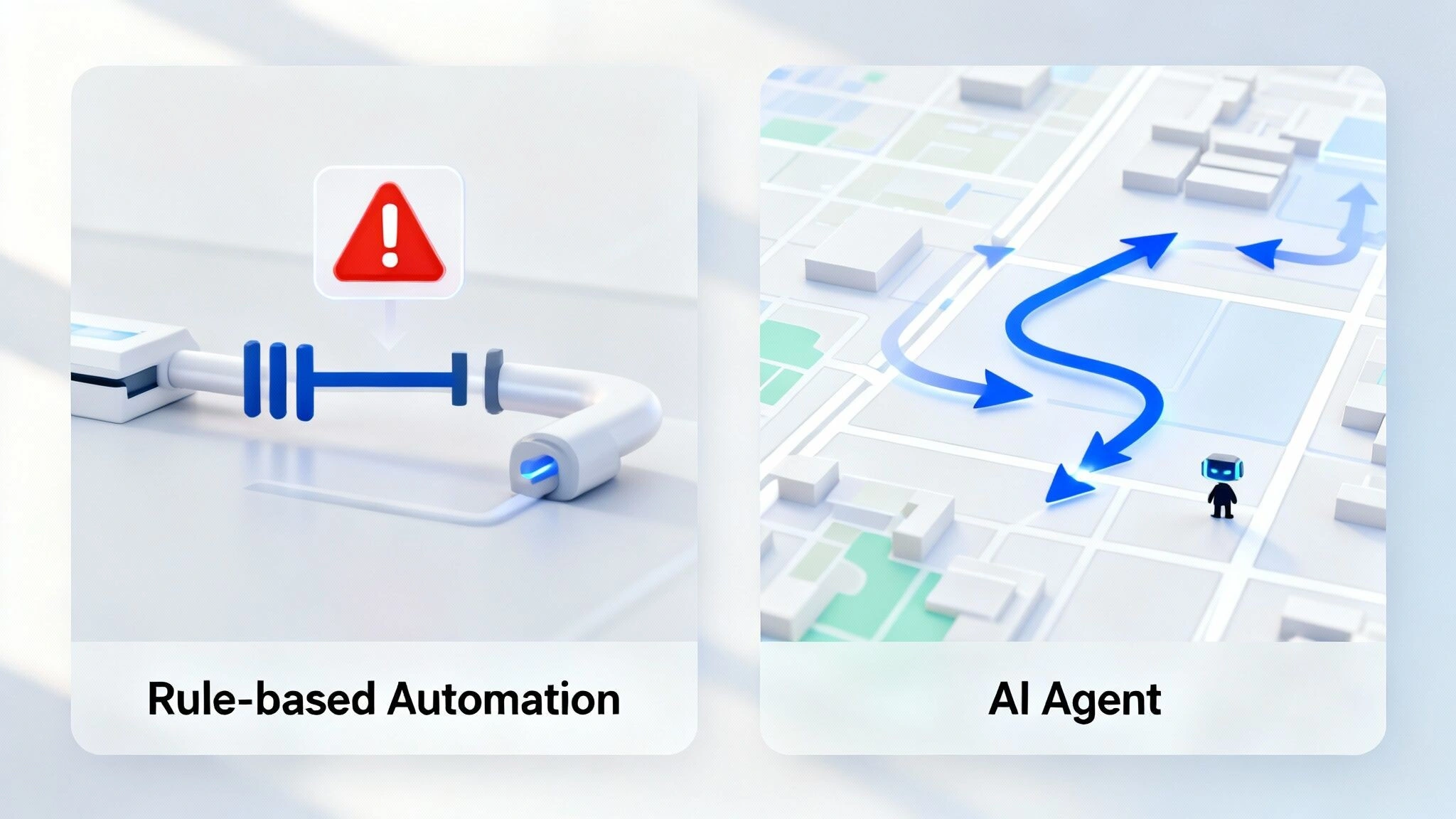
Alright, we’ve defined the players. Automation is the dependable rule-follower. AI agents are adaptive problem-solvers. But theory is one thing. What really matters is how they perform when things get messy—because in business, things always get messy.
This is where it gets real. It’s not about ticking off feature lists on a website. It’s about understanding their actual impact on your day-to-day headaches.
Let’s put them side-by-side and see how they really stack up when they’re faced with the things that cause real problems, like dealing with curveballs, handling different kinds of data, and fixing mistakes.
Dealing With the Unexpected
Picture this: a customer sends a support ticket through your website but accidentally leaves a crucial bit of information blank. It happens all the time.
With standard automation, the system hits a brick wall. Its rule is simple: “When all fields are complete, create a ticket.” A missing field breaks that rule, so the process just stops. It either throws the submission away or, more likely, flags it for a human to fix by hand. Now you’ve got a delay and someone on your team doing basic data entry. Not great.
An AI agent looks at this differently because its goal is to “resolve the customer’s issue.” It sees the missing info not as a dead end, but as a hurdle to get over. So, what does it do? It acts. It might send a friendly, automatic email: “Hey, looks like you missed this bit of info. Could you please provide it so we can help you faster?” The process keeps moving forward, no human needed.
That’s the core operational difference right there. Automation stops when the rules are broken. An AI agent problem-solves to keep things on track toward the goal.
The Data They Consume
Data is the fuel for both of these, but they have very different diets. This is a huge factor in the whole automation vs. AI agent discussion.
Automation thrives on clean, structured data. It needs information in predictable formats and places. Think cells in a spreadsheet, fields in a database, or structured web forms. It’s like a vending machine; you have to put the right coin in the right slot for it to work.
AI agents, however, can handle the messy stuff. They are built to process unstructured data, which is where most of our business information actually lives. This includes things like:
- The text inside customer emails or chat logs.
- The content of PDFs, reports, and contracts.
- Voice recordings from sales calls.
- Social media comments and reviews.
An agent can read an email, understand the feeling (is the customer happy or furious?), pick out the key issues, and then decide on the next best action. Automation would just see a block of text it can’t understand.
How They Handle Errors
No system is perfect, so what happens when something goes wrong? This is another place where they operate very differently.
An automation error is usually a simple yes/no event: it worked or it failed. When it fails, the process stops completely. It’s then up to a person to figure out why, fix the problem, and maybe re-run the whole thing. It’s a hard stop that needs you to step in.
An AI agent, on the other hand, is designed to learn from its mistakes. If an agent does something that leads to a bad outcome (like a poor customer satisfaction score), that feedback can be used to make better decisions in the future. It’s a continuous improvement loop. It has the ability to self-correct over time, getting better and better the longer it works.
This table gives a clearer, at-a-glance view of these big operational differences.
Operational Deep Dive: Automation vs. AI Agent
| Operational Aspect | Automation (Task-Driven) | AI Agent (Goal-Driven) |
|---|---|---|
| Adaptability to Change | Low. Fails or requires a human when processes or inputs change. | High. Can adapt its actions based on new information and context. |
| Data Requirements | Requires structured, predictable data (e.g., spreadsheets, databases). | Can interpret unstructured data (e.g., emails, PDFs, conversations). |
| Error Handling | Stops the process. Requires manual intervention and reprogramming to fix. | Learns from errors. Uses feedback to self-correct and improve future performance. |
Looking at them this way, it becomes so clear they aren’t just two flavours of the same thing. They are fundamentally different tools, built to solve entirely different kinds of problems.
How to Choose the Right Solution for Your Business
Alright, this is where it really matters. We’ve gone through the theory, but now you’re facing a real choice. One that will cost time, money, and let’s be honest, a fair bit of energy convincing people in your business. It can feel a bit overwhelming.
The secret is that this isn’t about picking the ‘best’ technology. There’s no such thing. It’s about finding the perfectly shaped key for the specific lock you’re trying to open. This is a strategic decision, not just a tech one.
I’ve seen it happen again and again. A team gets swept up in the hype around ‘AI’ and tries to force a complex agent into a simple, rules-based process. It’s like using a sledgehammer to hang a picture frame. Overkill. It’s expensive, complicated, and a total waste of a powerful tool.
And the other way is just as bad… trying to make basic automation handle a task that needs even a tiny bit of judgement is a recipe for pure frustration. You’ll spend all your time cleaning up the mess it makes every time it hits a small snag.
So, how do you get it right? You start by asking the right questions about the work itself.
A Practical Decision Framework
Let’s just put the buzzwords to one side for a moment and get practical. Take a really close look at a workflow you want to improve and be honest with yourself using these three questions. Your answers will point you straight to the right tool for the job.
1. How Predictable Is the Process?
Is the task a dead-straight line from A to B, every single time? Think about processing invoices that always arrive in the same standard format. The steps are rigid: get the document, scan specific fields, enter the data, send for approval. Simple.
- If it’s highly predictable: You’re squarely in automation territory. Its whole purpose is to execute a fixed script with perfect reliability, over and over.
- If it’s unpredictable: You absolutely need an AI agent. This is for jobs like managing customer support emails, where every single message is a unique mix of tone, history, and problems.
2. What Does the Data Look Like?
This one is a massive clue. Look at the information your system needs to work with. Is it all neat and tidy, or is it a bit of a chaotic mess?
The nature of your data is often the clearest signpost. Automation needs clean, organised inputs to function, while AI agents are built to find meaning in the chaos of real-world information.
Are you dealing with clear fields in a database or structured rows in a spreadsheet?
- If the data is structured: Automation is your best bet. It’s designed to work flawlessly with clean, organised data.
- If the data is unstructured: You’re looking at a job for an AI agent. It can understand the context in an email, find the meaning in a PDF contract, or figure out the feeling in a customer call recording.
3. Does the Outcome Require Judgement?
Finally, think about the end result. Does getting there require making a decision based on changing information? This is where the difference between completing a task and achieving a goal becomes so important.
Imagine you’re routing new sales leads. A simple system could use automation to assign them based on postcode alone. That’s a clear, unchanging rule. But what if you want to assign the lead to the sales rep who’s best suited to that specific industry, who also has the most free time this week, and who has the best closing rate with similar-sized companies?
- If the outcome is fixed: Stick with automation. The goal is simply to complete the defined task.
- If the outcome requires adaptation: This is a classic job for an AI agent. It can weigh up multiple factors, make a judgement call, and even learn from the results of its past decisions. Of course, this freedom comes with its own risks, and it’s vital to put the right protections in place. You can learn more by exploring the importance of creating effective AI agent guardrails to make sure they operate safely and within your business rules.
The Future of Work: A Symbiosis of Automation and AI Agents
After pulling apart the individual strengths of automation and AI agents, it’s easy to see them as competitors. But the reality is much more interesting than that. The smartest business strategies don’t involve a choice between the two. They focus on weaving them together into a single, powerful system.
The conversation is shifting from “automation vs. AI agents” to “automation and AI agents”. This partnership is where businesses unlock real operational smarts and a huge competitive edge.
Think of it like building a digital nervous system for your company.
In this setup, automation acts as the backbone. It reliably handles the high-volume, rule-based jobs that keep the lights on. It does the data entry, the system updates, and the report generation with speed and precision, creating a steady flow of structured, reliable data. This is the solid foundation of the whole operation.
That clean data then becomes the fuel for your AI agents.
Creating a Synergistic Workflow
Freed from the grunt work of routine data processing, the AI agent can focus on the bigger picture. It gets a constant stream of perfectly organised information, allowing it to move beyond just doing tasks and into the world of strategic analysis and finding hidden opportunities.
With this foundation, the agent can:
- Analyse emerging trends: It can spot subtle patterns in sales data or customer behaviour that would be almost impossible for a person to see in real-time.
- Predict future needs: By looking at historical data, it can anticipate what resources you’ll need, forecast customer demand, or predict potential problems in your supply chain.
- Make strategic recommendations: It might suggest which sales leads are most likely to convert or flag potential compliance risks long before they become serious issues.
This isn’t some far-off, futuristic idea. It’s a practical, actionable strategy for modernising your operations. The goal is to create a powerful feedback loop where efficiency and intelligent decisions constantly feed off each other.
The real breakthrough is when you let automation handle the scale of the work, which frees up your AI agents to provide the intelligence that drives the business forward.
A Real-World Example
Let’s ground this in a practical scenario for an e-commerce business.
-
Automation handles the process: A series of automation scripts manage thousands of daily transactions. They process orders, update inventory levels, and trigger shipping notifications. This is the core operational grunt work, done flawlessly.
-
The AI agent discovers the insight: An AI agent takes in all this structured sales and inventory data. It connects customer location, purchase history, and browsing behaviour, and finds that customers in Brisbane who buy a specific camera are 73% more likely to purchase a high-margin lens within two weeks.
-
Intelligent action is taken: The agent doesn’t just show this finding on a dashboard. It automatically kicks off a targeted marketing campaign, sending a personalised email to that specific group of customers in Brisbane with a compelling, time-sensitive offer on that exact lens.
In this example, automation managed the process, but the AI agent found the opportunity and started an intelligent response. This is the synergy that defines the future of work: the raw efficiency of automation, boosted by the adaptive, insightful decision-making of AI. One masters the ‘how’, while the other continuously optimises the ‘why’ and ‘what’s next’.
Frequently Asked Questions
We’ve covered a fair bit of ground, and if you’re still trying to get your head around the whole automation versus AI agent thing, you’re not alone. Let’s tackle a few of the most common questions I hear.
It’s one of those areas where the lines can feel a bit blurry, especially with just about every software company slapping an “AI” label on their products these days.
Can Basic Automation Software Use AI?
Absolutely, and this is probably the biggest source of confusion out there. Many modern automation platforms are now weaving in specific AI skills. It’s often called ‘intelligent automation’. Think of it as giving your trusty, rule-following bot a new, specialised skill.
A classic example is an automated invoicing workflow using Optical Character Recognition (OCR). Here, the AI’s only job is to ‘read’ and pull text from a scanned invoice. As soon as that data is pulled, the standard, rule-based automation takes over to process the payment according to its pre-set script.
The core process is still following a rigid set of instructions; it’s just been beefed up by a single AI skill. This is a world away from a fully autonomous AI agent that reasons its way to a goal.
So, while automation can certainly use AI, that doesn’t make it an AI agent. One is a feature, the other is the fundamental nature of the system.
Is an AI Agent More Expensive to Implement?
In almost every case, yes. You’re looking at a different level of investment for a completely different level of capability.
Setting up standard automation for clear, well-defined tasks can be relatively straightforward and affordable. You map the process, write the rules, and let it run.
AI agents, though, are a different beast altogether. They need a lot more:
- More complex development that needs specialised skills.
- Access to large, clean datasets for initial training.
- Ongoing maintenance to check performance and retrain the model.
But the real question isn’t about the upfront cost; it’s about the return on that investment. The higher price tag of an AI agent needs to be justified by the massive value it delivers—solving complex, high-impact business problems that simple automation couldn’t even touch.
What’s the Biggest Mistake Businesses Make?
This one’s easy. The most common pitfall is choosing a solution based on the hype rather than the actual problem you’re trying to solve.
Too many businesses get caught up in the excitement of ‘AI’ and immediately try to force a complex AI agent onto a simple, repetitive task. They’re chasing the shiny new toy. That’s like buying a Formula 1 car for the weekly grocery run. It’s expensive, needlessly complicated, and entirely the wrong tool for the job.
The right approach always starts with a deep, honest look at the process you want to improve. Be ruthless in your analysis. Only then should you pick the simplest, most effective tool that gets the job done properly.
Ready to move beyond the theory and see how the right solution can work for your business? At Osher Digital, we are an AI agency that specialises in developing custom automation and AI agents that solve real-world operational challenges. Let’s talk about building the right tool for your specific goals.
Jump to a section
Ready to streamline your operations?
Get in touch for a free consultation to see how we can streamline your operations and increase your productivity.